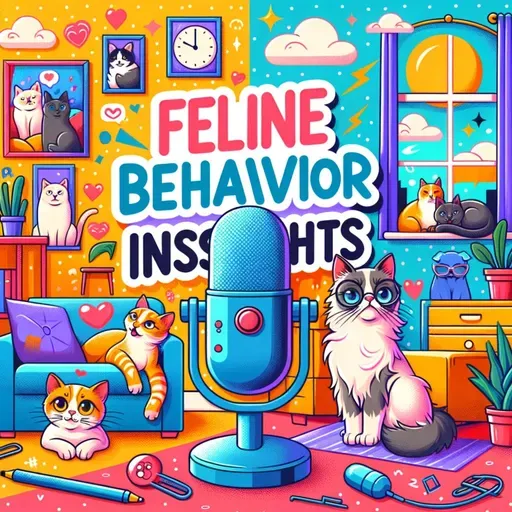
08 September 2025
Decode Your Cat's Language: Unlock the Secrets of Feline Body Language and Communication
Feline Behavior Insights
About
Today, we’re exploring feline behavior insights to help listeners better connect with their cats and decode what those subtle furry friends are trying to say. Cat communication hinges on body language far more than vocal cues. According to Tuft & Paw, a cat’s posture, tail position, and the way it moves are all clues to its current feelings and intentions. For example, a cat stretching out comfortably exposes itself and signals it feels safe, while crouching into a tight ball marks anxiety or unease; sometimes, this can even signal pain.
Best Friends Animal Society points out that relaxed cats display loose, flowing movements, and might slouch over a perch or tuck their legs underneath. Their ears and whiskers are set naturally, pupils are neither fully dilated nor contracted, and those slow blinks signal contentment. Cats also rub themselves on you, do little figure-eights, and knead your lap or soft blanket to show affection—kneading harkens back to nursing as kittens and is a sign your cat feels happy and secure.
MedVet explains that purring is usually a sign of contentment but can also indicate stress or pain. Meows are mainly directed at people, as cats use them especially to communicate wants and needs. Hissing and growling mean a cat feels threatened or frightened, reminding listeners to grant their cat some personal space in those moments.
Express Veterinary Hospital says the tail is one of the most telling parts of feline body language. A tail held high means confidence and friendliness, often inviting interaction and play. A puffed-out tail shows fear or agitation—a cat’s attempt at looking big to ward off threats—while a low or tucked tail signals fear or anxiety. It’s best to let your cat decompress if you notice the latter, as forced encounters could heighten stress. Ears also matter: relaxed and forward usually means comfort; flattened ears, along with dilated pupils, spell caution or stress.
Wikipedia reminds us that cats have complex social dynamics involving body language, elimination habits, play, and aggression. Territorial behaviors such as urine marking or bringing “gifts” like hunted bugs result from natural instincts and aren’t misbehavior—they’re cat compliments.
Listeners should stay observant of behaviors like knocking over objects; MedVet says this is natural curiosity and a display of their innate hunting instincts. Watching how your cat plays is crucial, as changes might indicate boredom or medical issues. Pets Best suggests that loafing—when a cat tucks its paws under its body—signifies contentment and warmth, not just adorable aesthetics.
Remember, every cat is a unique individual, and learning their signals deepens the bond and promotes their well-being. So next time you see your cat flicking its tail or giving you a gentle head bump, know it’s part of a robust language all their own.
Thank you for tuning in, and don’t forget to subscribe! This has been a Quiet Please production, for more check out quietplease dot ai.
For more http://www.quietplease.ai
Get the best deals https://amzn.to/3ODvOta
Best Friends Animal Society points out that relaxed cats display loose, flowing movements, and might slouch over a perch or tuck their legs underneath. Their ears and whiskers are set naturally, pupils are neither fully dilated nor contracted, and those slow blinks signal contentment. Cats also rub themselves on you, do little figure-eights, and knead your lap or soft blanket to show affection—kneading harkens back to nursing as kittens and is a sign your cat feels happy and secure.
MedVet explains that purring is usually a sign of contentment but can also indicate stress or pain. Meows are mainly directed at people, as cats use them especially to communicate wants and needs. Hissing and growling mean a cat feels threatened or frightened, reminding listeners to grant their cat some personal space in those moments.
Express Veterinary Hospital says the tail is one of the most telling parts of feline body language. A tail held high means confidence and friendliness, often inviting interaction and play. A puffed-out tail shows fear or agitation—a cat’s attempt at looking big to ward off threats—while a low or tucked tail signals fear or anxiety. It’s best to let your cat decompress if you notice the latter, as forced encounters could heighten stress. Ears also matter: relaxed and forward usually means comfort; flattened ears, along with dilated pupils, spell caution or stress.
Wikipedia reminds us that cats have complex social dynamics involving body language, elimination habits, play, and aggression. Territorial behaviors such as urine marking or bringing “gifts” like hunted bugs result from natural instincts and aren’t misbehavior—they’re cat compliments.
Listeners should stay observant of behaviors like knocking over objects; MedVet says this is natural curiosity and a display of their innate hunting instincts. Watching how your cat plays is crucial, as changes might indicate boredom or medical issues. Pets Best suggests that loafing—when a cat tucks its paws under its body—signifies contentment and warmth, not just adorable aesthetics.
Remember, every cat is a unique individual, and learning their signals deepens the bond and promotes their well-being. So next time you see your cat flicking its tail or giving you a gentle head bump, know it’s part of a robust language all their own.
Thank you for tuning in, and don’t forget to subscribe! This has been a Quiet Please production, for more check out quietplease dot ai.
For more http://www.quietplease.ai
Get the best deals https://amzn.to/3ODvOta